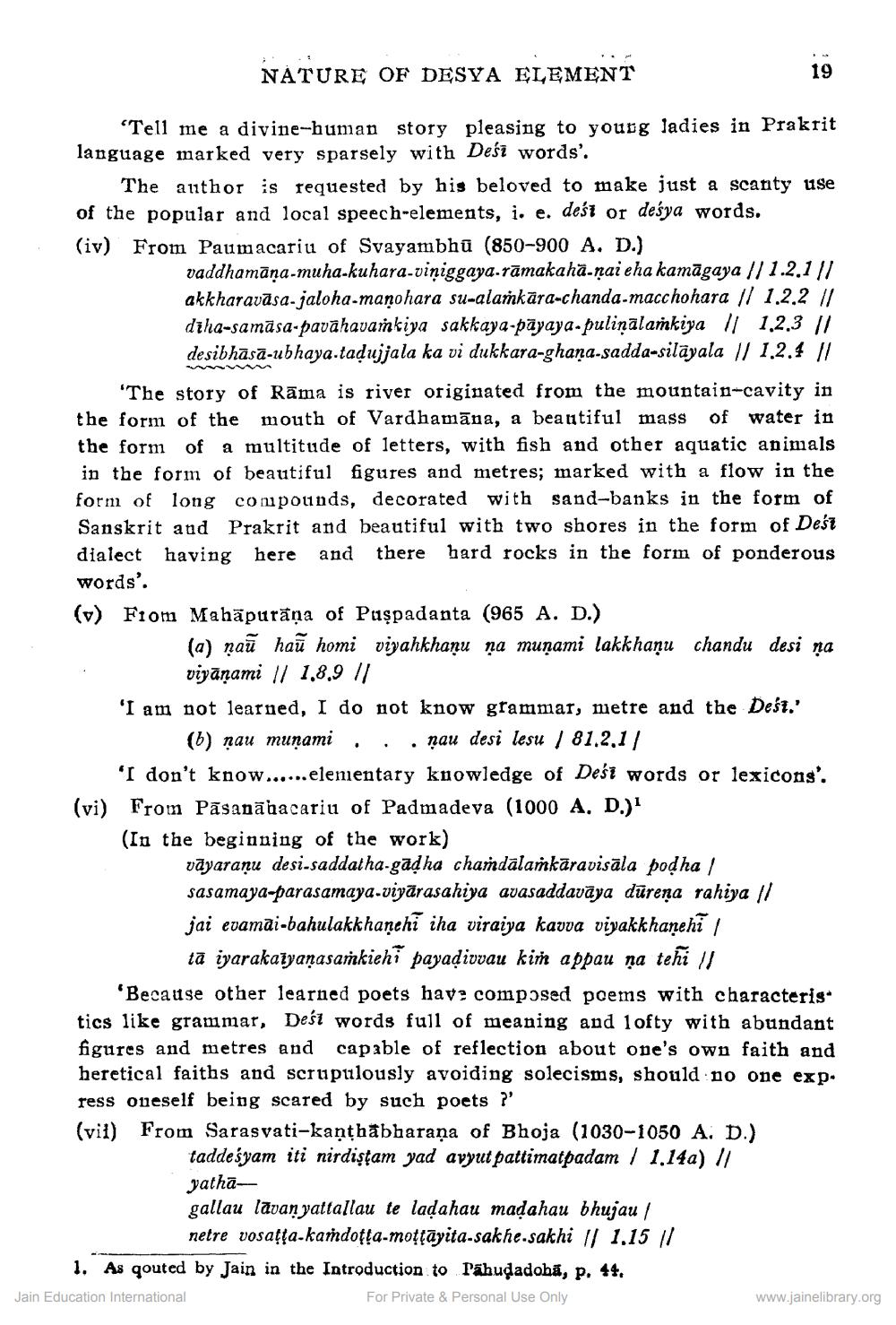________________
NATURE OF DESYA ELEMENT
Tell me a divine-human story pleasing to young ladies in Prakrit language marked very sparsely with Deść words'.
The author is requested by his beloved to make just a scanty use of the popular and local speech-elements, i. e. deść or deśya words. (iv) From Paumacariu of Svayambhū (850-900 A. D.)
vaddhamāņa-muha-kuhara-viniggaya.rāmakaha-ņai eha kamāgaya // 1.2.1 // akkharavāsa-jaloha-manohara su-alamkāra-chanda-macchohara // 1.2.2 // diha-samāsa-pavahavamkiya sakkaya-pāyaya.pulinālamkiya // 1.2.3 // desibhasa-ubhaya.tadujjala ka vi dukkara-ghana-sadda-silayala || 1.2.4 //
"The story of Rāma is river originated from the mountain-cavity in the form of the mouth of Vardhamāna, a beautiful mass of water in the form of a multitude of letters, with fish and other aquatic animals in the form of beautiful figures and metres; marked with a flow in the form of long compounds, decorated with sand-banks in the form of Sanskrit and Prakrit and beautiful with two shores in the form of Dest dialect having here and there hard rocks in the form of ponderous words'. (v) From Mahāpurāņa of Paşpadanta (965 A. D.)
(a) naŭ hañ homi viyahkhanu ņa munami lakkhanu chandu desi na
viyānami // 1.8.9 // 'I am not learned, I do not know grammar, metre and the Dest.'
(6) ņau munami... ņau desi lesu / 81.2.1/ 'I don't know...... elenientary knowledge of Deść words or lexicons'. (vi) From Pāsanādacariu of Padmadeva (1000 A. D.)' (In the beginning of the work)
vāyaranu desi-saddatha-gadha chandalamkāravisāla podha / sasamaya-parasamaya.viyarasahiya avasaddavāya dürena rahiya 11 jai evamai-bahulakkhanehi iha viraiya kavva viyakkhanehī /
tā iyarakaiyanasamkiehi payadivvau kim appau na teħi 11 'Because other learned poets have composed poems with characteris. tics like grammar, Deśl words full of meaning and 1 ofty with abundant figures and metres and capable of reflection about one's own faith and heretical faiths and scrupulously avoiding solecisms, should no one exp. ress oneself being scared by such poets ? (vii) From Sarasvati-kanthabharaṇa of Bhoja (1030-1050 A. D.)
taddeśyam iti nirdistam yad ayyut pattimatpadam/ 1.14a) // yathagallau lāvan yattallau te ladahau madahau bhujau/
netre vosatja.kardotta-moçãyita-sakhe.sakhi || 1.15 1/ 1. As qouted by Jain in the Introduction to Pāhugadohā, p. 44. Jain Education International For Private & Personal Use Only
www.jainelibrary.org




